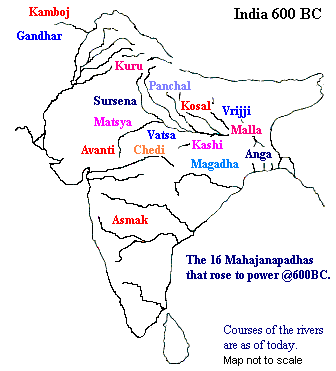Young growing Sivalik hills
(of the outer Himalayas)
(of the outer Himalayas)
&
worn down old fold mountains
(of Indian peninsular plateau)
(of Indian peninsular plateau)
1. Sivalik range are the hills, where one can see the geologically young tectonic activity,
rise of the fragile hills of the outer Himalayan range year by year,
2. And to it's south are the 'northern fertile plains of Ganges.
3. At the southern end of these plains are the region where Indian peninsular plateau
starts with
a. it's 5 old fold mountains mostly Archian in age,
b. worn down
due to weathering with no tectonic plate activity underneath.
 |
| The Sivalik hills are the southernmost and geologically youngest mountain range of the outer Himalayas The tectonically active zone of the Himalaya, are considered as the most dynamic formation where they annually rise up by 3 to 4mm. As being very young in geological formation and tectonically active, the hills exhibit a very conspicuous fragile terrain, they are bounded on the south by a fault system called the Main Frontal Thrust. |
Old fold mountains
(5 hill ranges of Indian peninsular plateau)
1. Old fold mountains are characterized by having stopped growing higher
due to the cessation of upward thrust caused by the stopping of movement
of the tectonic plates
in the Earth's crust below them.
2. In ancient times they were extremely high
but since have worn down almost completely by millions of years of weathering.
3. The cratons are mostly Archaean in age and are generally composed of
low-
1. Aravalli range Literally meaning 'line of peaks', a range of mountains in western India running approximately 800 km in a northeastern direction, are the oldest fold mountains in India. The northern end of the range continues as isolated hills and rocky ridges into Haryana state, ending in Delhi. The famous Delhi Ridge is the last leg of the Aravalli Range, which traverses through South Delhi and terminates into Central Delhi where Raisina hill is its last extension. It is one of the world's oldest mountain ranges. It dates back to a pre-Indian subcontinental collision with the mainland Eurasian Plate. The southern end is at Palanpur near Ahmedabad, Gujarat.(text credit:http://en.wikipedia.org/wiki/Aravalli_Range)
The system is divided into two sections: the Sambhar-Sirohi ranges, taller and including Guru Peak on Mount Abu, the highest peak in the Aravalli Range (5,650 feet [1,722 metres])(text credit:http://www.britannica.com/EBchecked/topic/32222/Aravalli-Range)
2. Satpura Range The name of which means 'Seven Folds', range of hills, part of the Deccan plateau, western India. The hills stretch for some 560 miles (900 km) across the widest part of peninsular India, through Maharashtra and Madhya Pradesh states. The Satpura Range includes the Mahadeo Hills to the north, the Maikala Range to the east, and the Rajpipla Hills to the west. Highest point of satpura range Dhupgarh is located in Pachmarhi.(text credit:http://www.britannica.com/EBchecked/topic/525030/Satpura-Range)
The range rises in eastern Gujarat state near the Arabian Sea coast, running east through the border of Maharashtra and Madhya Pradesh to the east till Chhattisgarh. The range parallels the Vindhya Range to the north, and these two east-west ranges divide Indian Subcontinent into the Indo-Gangetic plain of northern India and the Deccan Plateau of the south. The Narmada River originates from north-eastern end of Satpura & runs in the depression between the Satpura and Vindhya ranges, draining the northern slope of the Satpura range, running west towards the Arabian Sea. The Tapti River originates from eastern-central part of Satpura, crosses the range in the center & further runs at the southern slopes of Satpura towards west meeting the Arabian Sea at Surat, draining central & the southern slopes of the Satpura Range. The Godavari River and its tributaries drain the Deccan plateau, which lies south of the range, and the Mahanadi River drains the easternmost portion of the range. The Godavari and Mahanadi rivers flow into the Bay of Bengal. At its eastern end, the Satpura range meets the hills of the Chota Nagpur Plateau.(text credit:http://en.wikipedia.org/wiki/Satpura_Range)
3. Vindhya range 'Vaindh' (to obstruct) or 'Vindhya' means 'hunter' in Sanskrit, and may refer to the adivasi (tribal) hunter-gatherers inhabiting the region, refers to a complex, discontinuous chain of mountain ridges, hill ranges, highlands and plateau escarpments in west-central India, located to the north of the Narmada River.
A series of hills connects the Vindhya extension to the Aravalli Range near Champaner.
A southern chain of runs between the upper reaches of the Son and Narmada rivers to meet the Satpura Range in the Maikal Hills near Amarkantak.
4. Western Ghats( the Sahyadris) Forming the western edge of the Deccan tableland, the Western Ghats run in north-south direction, parallel and close to the Arabian Sea coast, from the Tapi valley to a little north of Kanniyakumari for a distance of 1,600 km. यह वास्तविक पर्वतश्रेणी नहीं है वरन प्रायद्वीपीय पठार का ही एक भ्रंश कगार है। यह उस भ्रंश का द्योतक है जो अफ्रीका से भारत के अलग होते समय उत्पन्न हुआ था।
5. Eastern Ghats Bordering the eastern edge of the Deccan Plateau, the Eastern Ghats run almost parallel to the east coast of India leaving broad plains between their base and the coast. In striking contrast to the continuous eminence of the Western Ghats, it is a chain of highly broken and detached hills starting from the Mahanadi in Orissa to the Vagai in Tamil Nadu.
#author wishes thanks to Ms Padmavati Pandey for her extensive support during researching this topic.
#reference cited links are thankfully quoted at appropriate place.
































